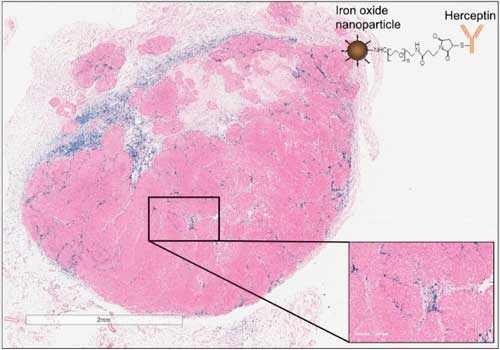| Mar 26, 2020 | |
Experiments in mice and human cells shed light on best way to deliver nanoparticle therapy for cancer(Nanowerk News) Researchers in the cancer nanomedicine community debate whether use of nanoparticles can best deliver drug therapy to tumors passively — allowing the nanoparticles to diffuse into tumors and become held in place, or actively — adding a targeted anti-cancer molecule to bind to specific cancer cell receptors and, in theory, keep the nanoparticle in the tumor longer. |
|
| Now, new research on human and mouse tumors in mice by investigators at the Johns Hopkins Kimmel Cancer Center suggests the question is even more complicated. | |
| Laboratory studies testing both methods in six models of breast cancer; five human cancer cell lines and one mouse cancer in mice with three variants of the immune system found that nanoparticles coated with trastuzumab, a drug that targets human epidermal growth factor receptor 2 (HER2)-positive breast cancer cells, were better retained in the tumors than plain nanoparticles, even in tumors that did not express the pro-growth HER2 protein. | |
| However, immune cells of the host exposed to nanoparticles induced an anti-cancer immune response by activating T cells that invaded and slowed tumor growth. | |
 |
|
| Histology image of HER2+ tumor showing accumulation of Herceptin-labeled nanoparticle (upper right, and blue in histology) accumulation in tumor microenvironment (immune) and not on HER2+ cancer cells. (Image: Robert Ivkov) | |
| A description of the work has been published in Science Advances ("Nanoparticle interactions with immune cells dominate tumor retention and induce T cell–mediated tumor suppression in models of breast cancer"). | |
| “It’s been known for a long time that nanoparticles, when injected into the bloodstream, are picked up by scavengerlike macrophages and other immune system cells,” explains senior study author Robert Ivkov, Ph.D., M.Sc., associate professor of radiation oncology and molecular radiation sciences at the Sidney Kimmel Comprehensive Cancer Center at Johns Hopkins. “Many researchers in the field have been focused on trying to reduce interactions with immune cells, because they have been trying to increase the circulation time of the nanoparticles and their retention in tumor cells. But our study demonstrates that the immune cells in the tumor collect and react to the particles in such a way to stimulate an anti-cancer response. This may hold potential for advancing beyond drug delivery toward developing cancer immunotherapies.” | |
| The investigators conducted a few in vitro experiments in their study. First, they applied some plain starch-coated iron oxide nanoparticles and others coated with trastuzumab to five human breast cancer cell lines, finding that the amount of binding between the trastuzumab-coated nanoparticles and cells depended on how much the cancer cells expressed the oncogene HER2. | |
| In people, HER2-positive breast cancers are among the most resistant to standard chemotherapy. Trastuzumab, sold under the name Herceptin, targets the HER2-positive tumor cells and triggers the immune system as well. | |
| Responses were surprisingly different in animal models, the researchers report. In separate experiments, the team used the nanoparticles in two immune-deficient strains of mice engrafted with cells from five human breast cancer cell lines — two that were HER2 negative and three that were HER2 positive. | |
| When they studied the animals’ tumors 24 hours later, they noticed that nanoparticles coated with trastuzumab were found in a concentration two to five times greater than the plain nanoparticles in all types of tumors, regardless of whether they expressed the HER2 protein. They also found that the amount of trastuzumab-coated nanoparticles was even greater (tenfold) in mice that had a fully functional immune system and were bearing mouse-derived tumors. | |
| This led the researchers to suspect that the host animals’ immune systems were interacting strongly with the nanoparticles and playing a role in determining retention of the particles in the tumor, whether or not a drug was added. | |
| More experiments, the team reports, revealed that tumor-associated immune cells were responsible for collecting the nanoparticles, and that mice bred with an intact immune system retained more of the trastuzumab-coated nanoparticles than mice bred without a fully functioning immune system. | |
| In addition, inflammatory immune cells in the tumors’ immediate surroundings, or microenvironment, seized more of the coated nanoparticles than the plain ones. Finally, in a series of 30-day experiments, the researchers found that exposure to nanoparticles inhibited tumor growth three to five times more than controls, and increased CD8-positive cancer-killing T cells in the tumors. | |
| Surprisingly, Ivkov notes, the anti-cancer immune activating response was equally effective with exposure to either plain or trastuzumab-coated nanoparticles. Mice with defective T cells did not show tumor growth inhibition. The investigators say this demonstrated that systemic exposure to nanoparticles can cause a systemic host immune response that leads to anti-cancer immune stimulation, and does not require nanoparticles to be inside the tumors. | |
| “Overall, our work suggests that complex interdependencies exist between the host and tumor immune responses to nanoparticle exposure,” Ivkov says. “These results offer intriguing possibilities for exploring nanoparticle ‘targeting’ of the tumor immune microenvironment. They also demonstrate exciting new potential to develop nanoparticles as platforms for cancer immune therapies.” | |
| The investigators say they also plan to study whether the same types of immune responses can be generated for noncancer conditions, such as infectious diseases. |
| Source: The Johns Hopkins University | |
|
Subscribe to a free copy of one of our daily Nanowerk Newsletter Email Digests with a compilation of all of the day's news. |
